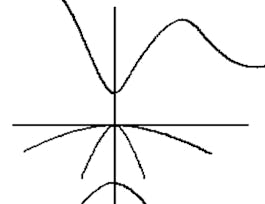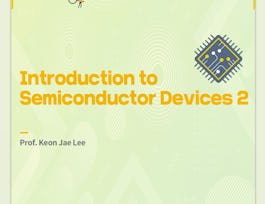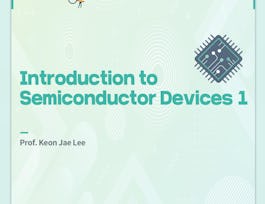This course can also be taken for academic credit as ECEA 5632, part of CU Boulder’s Master of Science in Electrical Engineering degree.



Transistor - Field Effect Transistor and Bipolar Junction Transistor
This course is part of Semiconductor Devices Specialization

Instructor: Wounjhang Park
Sponsored by Syrian Youth Assembly
12,533 already enrolled
(83 reviews)
What you'll learn
Describe and analyze metal-oxide-semiconductor (MOS) device
Describe and analyze MOS field effect transistor (MOSFET)
Describe and analyze bipolar junction transistor (BJT)
Details to know

Add to your LinkedIn profile
3 assignments
See how employees at top companies are mastering in-demand skills

Build your subject-matter expertise
- Learn new concepts from industry experts
- Gain a foundational understanding of a subject or tool
- Develop job-relevant skills with hands-on projects
- Earn a shareable career certificate


Earn a career certificate
Add this credential to your LinkedIn profile, resume, or CV
Share it on social media and in your performance review

There are 3 modules in this course
In this module on MOS devices, we will cover the following topics:, MOS device structure, energy band diagram for MOS device at equilibrium, Flat band condition, Accumulation, Depletion, and Inversion of MOS under bias, Energy band diagram and charge distribution for MOS in inversion, Quantitative model and relevant parameters, Energy band diagram with channel bias, Inversion layer charge, and Effect on threshold voltage of MOS in non-equilibrium, C-V characteristics: Charge distribution under different biasing conditions, C-V characteristics: Frequency dependence, Effects of oxide charge on flat band and threshold voltages in non-ideal MOS, and Types of oxide charge in non-ideal MOS.
What's included
8 videos4 readings1 assignment1 discussion prompt
In this module on MOSFETs (metal-oxide semiconductor field effect transistors), we cover the following topics: History of development of MOSFETs, Device structure, Device types, Circuit symbols, Long channel theory, I-V characteristics, Modes of operation, Channel length modulation, Body bias effect, Bulk charge effect, Sub-threshold conduction, Source/drain charge sharing in short channel devices, Drain induced barrier lowering, Subsurface punchthrough, Mobility degradation, Velocity saturation, Drain current saturation, Scaling of drain current with channel length, and Scaling of speed with channel length.
What's included
7 videos3 readings1 assignment
In this module on BJTs (bipolar junction transistors), we will cover the following topics: BJT Device structures, Energy band diagrams, Active bias, Leakage current, Recombination in base, Hoe injection, Non-uniform doping in base, Current gain, Switching with BJT, Single heterojunction bipolar transistor, Double heterojunction bipolar transistor, Non-uniform material, Early effect, Emitter bias dependence, High-level injection, Base, emitter and collector transit times, and RC time constant.
What's included
6 videos3 readings1 assignment1 peer review
Instructor

Offered by
Why people choose Coursera for their career




Recommended if you're interested in Physical Science and Engineering

University of Colorado Boulder

Korea Advanced Institute of Science and Technology(KAIST)

Columbia University

Korea Advanced Institute of Science and Technology(KAIST)

Open new doors with Coursera Plus
Unlimited access to 10,000+ world-class courses, hands-on projects, and job-ready certificate programs - all included in your subscription
Advance your career with an online degree
Earn a degree from world-class universities - 100% online
Join over 3,400 global companies that choose Coursera for Business
Upskill your employees to excel in the digital economy


